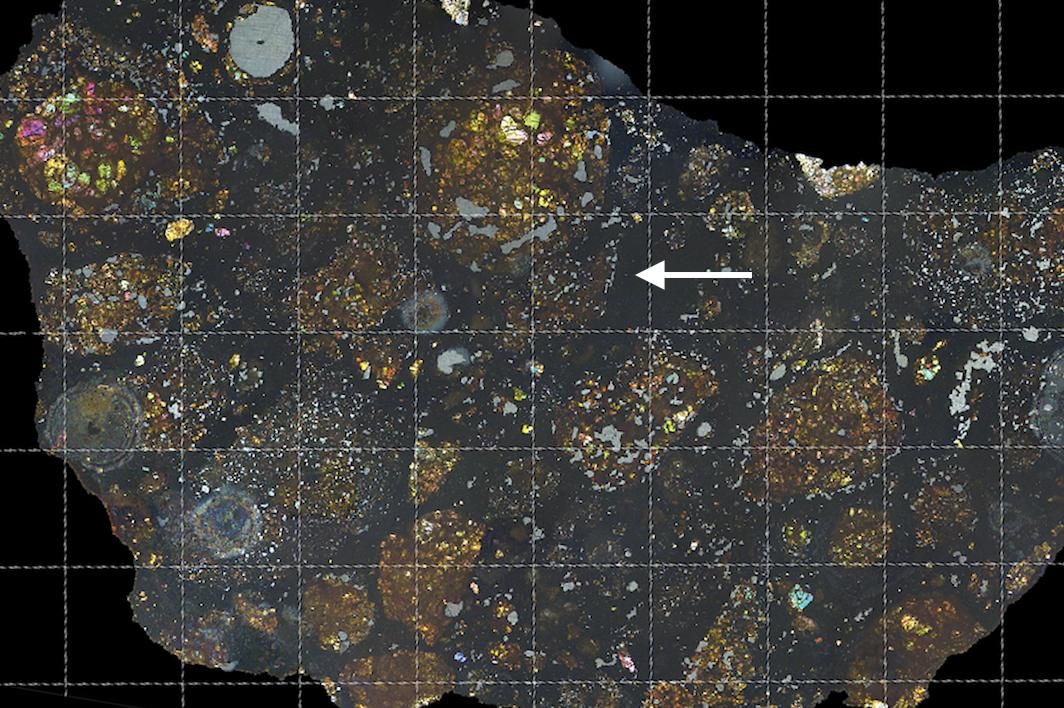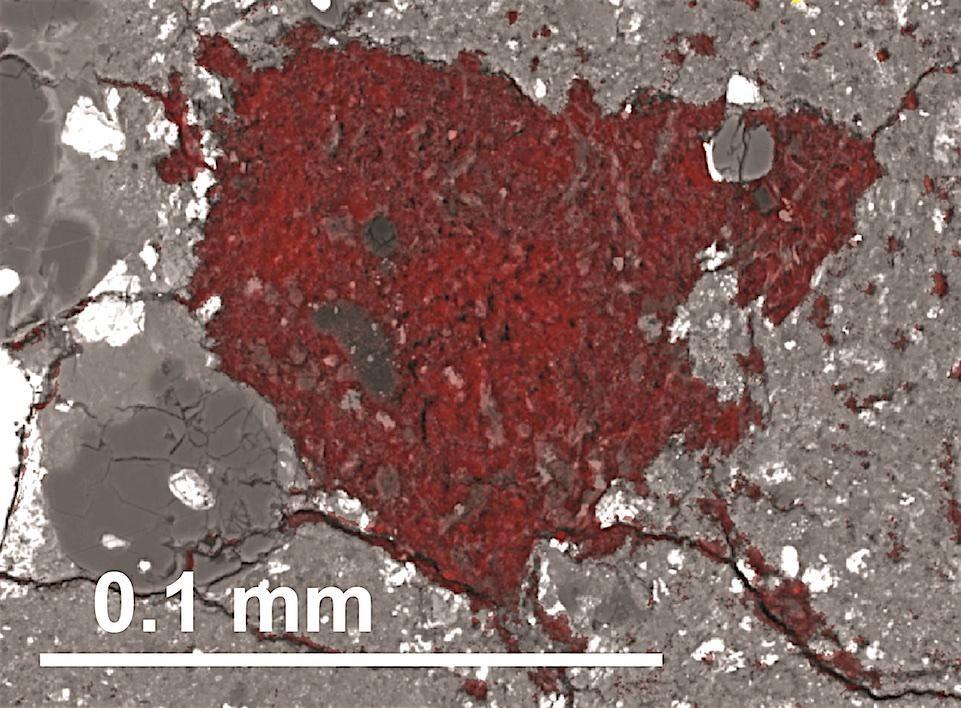
A tiny piece of the building blocks from which comets formed has been discovered inside a primitive meteorite. The discovery by a Carnegie Institution for Science-led team, including a researcher now at Arizona State University, was published April 15 in Nature Astronomy.
The finding could offer clues to the formation, structure and evolution of the solar system.
"The meteorite is named LaPaz Icefield 02342," said research scientist Jemma Davidson, of ASU's Center for Meteorite Studies in the School of Earth and Space Exploration. "The name comes from where it was found in Antarctica's LaPaz Icefield."
She adds that it belongs to a class of primitive carbonaceous chondrite meteorites that have undergone minimal changes since they formed more than 4.5 billion years ago, likely beyond the orbit of Jupiter.
Construction debris
Meteorites were once part of larger bodies, asteroids, which broke up due to collisions in space and then survived the trip through Earth's atmosphere. Their makeup can vary substantially from one meteorite to the next, reflecting their origins in diverse parent bodies that formed in different parts of the solar system.
Asteroids and comets both formed from the disk of gas and dust that once surrounded the young sun, but they aggregated at different distances from it, which affected their chemical makeup. Compared to asteroids, comets contain larger fractions of water ice and far more carbon, and typically formed farther from the sun where the environment was colder.
Comment:
Earth Changes and The Human cosmic ConnectionComets or Asteroids
The fundamental difference between asteroids and comets is not their chemical composition, i.e. dirty, fluffy icy comets vs. rocky asteroids. Rather, as has long been put forward by plasma theorists, what differentiates 'comets' from 'asteroids' is their electric activity.
When the electric potential difference between an asteroid and the surrounding plasma is not too high, the asteroid exhibits a dark discharge mode or no discharge at all. But when the potential difference is high enough, the asteroid switches to a glowing discharge mode. At this point the asteroid is a comet. From this perspective, a comet is simply a glowing asteroid and an asteroid is a non-glowing comet. Thus the very same body can, successively, be a comet, then an asteroid, then a comet, etc., depending on variations in the ambient electric field it is subjected to.
By studying a meteorite's chemistry and mineralogy, researchers such as the paper's lead author, Carnegie's Larry Nittler, can unlock details about its formation and how much heating and other chemical processing it experienced during the solar system's formative years.

Approximately 3 million to 3.5 million years after the solar system formed, but while Earth was still growing, this tiny object - about one-tenth of a millimeter across - was captured by the growing asteroid from which the meteorite originated.
"Primitive meteorites provide a snapshot of the early solar system that we can study in the lab," Davidson said. "The LaPaz meteorite is a nice example since it has experienced minimal terrestrial weathering."
Meteorites like LaPaz, she notes, are great places to hunt for presolar grains, microscopic pieces of stardust formed by stars that predate the solar system. But none of the team expected also to find evidence for a surviving cometary building block inside a meteorite.
Ancient survivor
"When I saw the first electron images of the carbon-rich material," Davidson said, "I knew we were looking at something very rare. It was one of those exciting moments you live for as a scientist."
By undertaking sophisticated chemical and isotopic analysis of the material, Nittler and his colleagues - who besides Davidson include Carnegie's Conel Alexander as well as Rhonda Stroud and Bradley De Gregorio of the U.S. Naval Research Laboratory, and Josep Trigo-Rodríguez, Carles Moyano-Cambero and Safoura Tanbakouei of the Institute of Space Sciences in Barcelona, Catalonia - were able to show that the encased material likely originated in the icy outer solar system along with objects from the Kuiper Belt, where many comets originate.
"Because this sample of cometary building-block material was swallowed by an asteroid and preserved inside this meteorite, it was protected from the ravages of entering Earth's atmosphere," Nittler explained. "It gave us a peek at material that would not have survived to reach our planet's surface on its own, helping us to understand the early solar system's chemistry."
The existence of this primitive material captured inside the meteorite suggests that due to the drag caused by the surrounding gas, particles like it migrated from the outer edges of the solar system, where comets and Kuiper Belt objects formed, to the closer-in area beyond Jupiter, where the carbonaceous chondrites formed. This reveals details about how our solar system's architecture took shape during the early stages of planet formation.
"Discoveries like this demonstrate how important it is to retrieve precious meteorites like LaPaz from Antarctica," Davidson said. "We never know what secrets they'll reveal."



But c'mon:
• Asteroid: A celestial body bigger than 10 m orbiting the Sun, mainly between Mars and Jupiter. [composed of what?]
• Meteoroid: Similar to an asteroid but significantly smaller. Mostly debris of comets, sometimes debris of asteroids.
• Meteor: A bright tail of light caused by a meteoroid during its atmospheric flight, also called a shooting star or falling star.
• Fireball: A very bright meteor (brighter than the planet Venus).
• Bolide: A fireball that explodes during its atmospheric flight, often with visible fragmentation.
• Meteorite: The part of a meteoroid or asteroid that survives the passage through our atmosphere and reaches the Earth's surface.
• Comet: A smaller celestial body mainly composed of ice and dust. If a comet approaches the Sun it can generate a tail of gas and/or dust.
[Link] - where more explanation is available to those with the patience to delve into this further.
From the summary chart, a bolide is an exploding fireball which is a bright meteor which is itself a 'bright tail of light' from a meteoroid which is just debris from comets which are ice and dust or from meteors which are "bright tails...", etc. There's a lot of incestual nomenclature going on.
It's all clear as mud (or ice or 'debris' or 'dust' or gas or ...) to me. I'd go for little space object as in Little Space Object 29J19 (LSO-29J19) is entering the atmosphere, is developing a tail near the sun, has been photographed in a fly-by, etc.